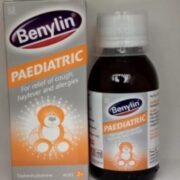First Aid Kit For Babies

More than 1 million children a year are involved in an accident in the home. Most aren’t serious, but it’s sensible to make sure your first aid box contains the essentials.
Choose a waterproof, durable box that’s easy to carry. It’s much easier to take the box to the child than the child to the box. The box should have a childproof lock and be tall enough to carry bottles of lotion. Keep the box out of the reach of children, but handy for adults. You don’t want to be hunting for your first aid kit when a child is injured and frightened.
Either buy a first aid box, which is green with a white cross, or, if making up your own box, write “First Aid” on it so if you aren’t around, other people know what it is. If someone else is caring for your children, let them know where the kit is kept.
Painkillers and babies
Make sure you have an age-appropriate painkiller that contains paracetamol or ibuprofen, which can be used for headaches and fevers. You will also need a measuring spoon or, for younger children, a no-needle dosing syringe. Always follow the dosage instructions on the label.
Dressings for babies
- Sticking plasters. Buy them in a variety of sizes for minor cuts, blisters and sore spots.
- Adhesive tape. This can hold dressings in place and can also be applied to smaller cuts.
- Bandages. Crepe bandages are useful for support or holding a dressing in place. Tubular bandages are helpful when a child has strained a joint and needs extra support. You can also buy triangular bandages that can be used for making a sling.
- Sterile gauze dressings. These are good for covering larger sore areas and cuts.
Antiseptic cream or spray
Antiseptic cream or spray can be applied to cuts, grazes or minor burns after cleaning to help prevent infection. Some may also contain a mild local anaesthetic to numb the pain.
Antihistamine cream
This can reduce swelling and soothe insect bites and stings.
Thermometer
- Digital thermometers. Digital thermometers are quick to use, accurate and can be used under the armpit (always use the thermometer under the armpit with children under five). Hold your child’s arm against his or her body and leave the thermometer in place for the time stated in the manufacturer’s instructions.
- Ear (or tympanic) thermometers. Ear thermometers are put in the child’s ear. They take the child’s temperature in one second and do not disturb the child, but they’re expensive. Ear thermometers may give low readings when not correctly placed in the ear, so read the manufacturer’s instructions carefully and familiarize yourself with how the thermometer works (this applies to all thermometers).
- Strip-type thermometers. Strip-type thermometers, which you hold on your child’s forehead, are not an accurate way of taking their temperature. They show the temperature of the skin, not the body.
- Mercury-in-glass thermometers. Mercury-in-glass thermometers haven’t been used in hospitals for some years and are no longer available to buy. They can break, releasing small shards of glass and highly poisonous mercury. Do not use mercury thermometers. If your child is exposed to mercury, get medical advice immediately.
Calamine lotion
This can help to soothe itching irritated skin, rashes (including chicken pox) and sunburn.
Baby first aid accessories
- Small pair of scissors for cutting plasters and tape to size.
- Tweezers to remove thorns, splinters and bee stings.
- Ice packs or gel packs can be kept in the fridge and applied to bumps and bruises to relieve swelling. A packet of frozen peas is just as good, but wrap it in a clean tea towel before applying it to skin. Direct contact with ice can cause a “cold burn”.
- Saline solution and an eye bath. This is useful for washing specks of dust or foreign bodies out of sore eyes.
Antiseptic wipes
Antiseptic wipes are a handy way to clean cuts and grazes and help prevent infection. To use them, take a fresh wipe and clean the wound, gently working away from the centre to remove dirt and germs.
Remember to keep your first aid box up to date. Replace items when stocks have been depleted and check use-by dates of all medicines. Throw away anything past its use-by date. You can take any out-of-date medicines to a pharmacy, which will dispose of them safely.
Source: nhs.uk



Nice one!!! Hv got thermometer @home.
The important things we take for granted.Noted MISM,thanks.
tnx ooo
Noted. Thanks MISM
nice tips….. Very helpful thanks
We used to have this kit growing up as kids, but i can’t believe ive never thought about it since i became a parent. Thanks for this reminder, i will do just that.
Nice tips. Tanx a lot MISM
Tanks
Thanks ma’am. Noted
great tips!
Noted
Thank u
Tanx
I love dis, wonderful tips.
Thanks MISM.Will go and get mine asap
Very helpful..thanks MISM
noted.
I do have one at home..its important.
Things we take for granted. Thakns for always keeping us informed…
Will try n put them together in one box/bag bcos they are in different places.Thanx 4 d reminder
tnks hv got abt three at home
Thanks.
I have got most of these things at home not in one bag though. ..
Tnx i will to get them complete
I really should get these
Ooh tnks alot